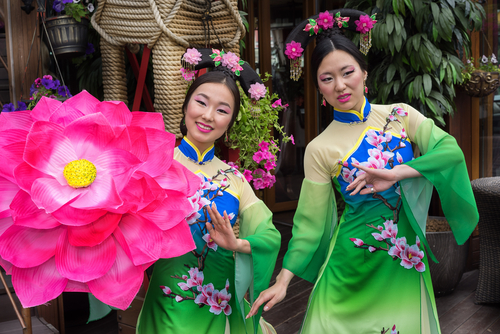Is a Chinese-Style Prom Dress Cultural Appropriation?
What exactly is cultural appropriation?
A 2017 Opinion piece, quoting Susan Scafidi, a law professor at Fordham University, defined it as:
“taking intellectual property, traditional knowledge, cultural expressions, or artifacts from someone else’s culture without permission.” This can include the “unauthorized use of another culture’s dance, dress, music, language, folklore, cuisine, traditional medicine, religious symbols, etc.”
Other Times articles have called it “a sign of disrespect and exploitation” and “a word now associated with the white Western world’s co-opting of minority cultures.”
Can you recall any examples of cultural appropriation from the news or your own life? What were they and what made them disrespectful or exploitative?
In “Teenager’s Prom Dress Stirs Furor in U.S. — but Not in China,” Amy Qin writes:
When Keziah Daum wore a Chinese-style dress to her high school prom in Utah, it set off an uproar — but not because of its tight fit or thigh-high slit.
After Ms. Daum, 18, shared pictures on social media of her prom night, a Twitter user named Jeremy Lam hotly responded in a post that has been retweeted nearly 42,000 times.
“My culture is NOT” your prom dress, he wrote, adding profanity for effect.
“I’m proud of my culture,” he wrote in another post. “For it to simply be subject to American consumerism and cater to a white audience, is parallel to colonial ideology.”
Some Twitter users who described themselves as Asian-Americans seized on Ms. Daum’s dress — a form-fitting red cheongsam (also known as a qipao) with black and gold ornamental designs — as an example of cultural appropriation, a sign of disrespect and exploitation. Other Asian-Americans said the criticism was silly.
“This isn’t ok,” wrote someone with the user name Jeannie. “I wouldn’t wear traditional Korean, Japanese or any other traditional dress and I’m Asian. I wouldn’t wear traditional Irish or Swedish or Greek dress either. There’s a lot of history behind these clothes. Sad.”
When the furor reached Asia, though, many seemed to be scratching their heads. Far from being critical of Ms. Daum, who is not Chinese, many people in mainland China, Hong Kong and Taiwan proclaimed her choice of the traditional high-necked dress as a victory for Chinese culture.
“I am very proud to have our culture recognized by people in other countries,” said someone called Snail Trail, commenting on a post of the Utah episode by a popular account on WeChat, the messaging and social media platform, that had been read more than 100,000 times.
Students: Read the entire article, then tell us:
— After reading multiple perspectives, do you think Ms. Daum’s prom dress was an example of cultural appropriation? Or is it just another instance of American “outrage culture”? Why do you think so?
— In your opinion, when does something cross the line from “cultural exchange” into “appropriation” and why?
— With more access to other cultures and perspectives via the internet, do you think people today have a greater responsibility to seek out and attempt to understand how their use of cultural artifacts might offend others? Why or why not?
— What is your opinion on the increasingly complex, nuanced and sensitive conversations about race in the United States?

